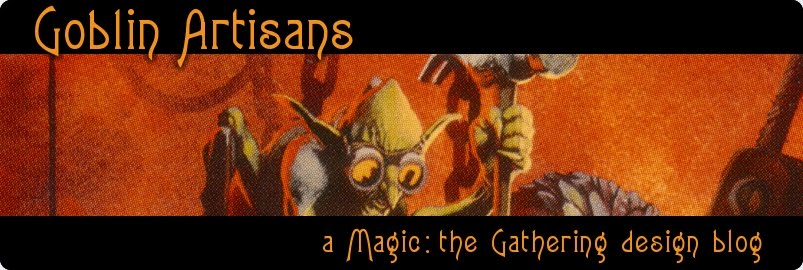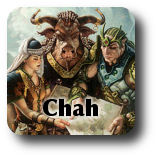Recent sets such as Rise of the Eldrazi or M11 have been very successful at emphasizing archetypes in their Limited environments. In these sets, you try to draft a deck with a coherent strategy or game plan, rather than just pick cards based on how good they are on their own.
While any given card set would naturally contain some archetypes, some environments are more friendly to archetype-based drafting than others.
In this post, I'd like to discuss the benefits of sets emphasizing archetype-based Limited.
But first, I'd like to mention some quick examples of archetypal drafting.
This video draft tech from 2010 is a prime example of how much archetypes mattered in M11. In the first draft that the video talks about, Brad Nelson is drafting a Red-Green deck and he picks a Yavimaya Wurm over a Chandra's Outrage, even though the Outrage is a far superior card in a vacuum. The reason was that he had Pyroclasm and was generally shaping up towards a fatty Red-Green deck rather than an aggro Red-Green deck. The Outrage has a clunky cost for a fatty deck while being excellent in a beatdown deck.
In the second draft within the same video, Brad deduces that the player to his right is drafting Blue, but decides to go into Blue anyways. Brad knew the player to the right favored control decks. The Blue cards that control decks want are different from the Blue cards that aggro decks want, and Brad wanted the aggro cards.
Brad went undefeated in both of these drafts.
So, some sets are about drafting decks, not cards. What are the benefits when sets emphasize deck archetypes?
1) Diversity of Play Experience
First of all, the set can provide more diverse play experiences, even though the overall number of cards in a set is about the same in each set. You might play a control deck in one draft, and an aggro deck in another. You might play a flyers deck that deals a steady stream of damage every turn backed up with tempo tricks, or you might play a fatty deck that stomps over the opponent with sheer size, using burn spells to survive the opponent's early creatures.
This diversity means two things: First, the set can cater to players who have various prefrences in play style. Secondly, the set doesn't get boring after repeated drafts. After 20-30 drafts, you may have tried a large portion of the set's cards, but there are still new strategies to concoct by putting cards together in a different mix. Players can continue to discover new things over repeated drafts.
Individual cards also show different sides to themselves in each archetype. In one draft, you grudgingly use Fling as a 23rd card because you desperately need some kind of removal. In another draft, you're drafting an aggro Red-Green deck and you find that you actively want a few Flings in your deck - because you can reasonably hope to attack with a Garruck's Companion, Titanic Growth it, then Fling it to deal 14 damage in one turn.
Note that this isn't just about combos, but rather about a deck's priorities. Even if you don't get the combo, the Red-Green aggro deck above might be fast enough that you can afford to throw away card advantage for a game-closing Fling.
2) Skill Matters
Archetypes also allow skill to matter despite powerful bombs being in a set. You can often beat a janky deck with many bombs when your cards come together in a smooth, coherent strategy. There's more potential to out-draft or out-build lucky opponents.
3) The Fun of Playing Actual "Decks"
Archetypes are also just fun to play. Whether you're attacking with a horde of Jackal Familiars and Zephyr Sprites and closing the game with Lava Axes, drawing cards with Scroll Thiefs backed up by Unsummons and Excommunicates, or placing a Spirit Mantle on a Griffin Sentinel and recurring the Aura with an Auramancer, it's really fun when you put cards together and they "click" to produce more value than the sum of their parts.
Making cards work together in a deck strategy is a fundamental part of what makes Magic fun, and archetypes bring that to Limited.
4) Deep Decisions in the Drafting Process
During the drafting process, there's a certain joy in building a functional deck on the fly. There's the fun of gradually forming your strategy with each pick, narrowing things down as you face forks in the road along the way.
Spined Wurm was a card I personally enjoyed in Xth Edition. I think it had good stats for its cost in that era, and I didn't mind picking it highly. Once I picked it, I had fun thinking about how it fits into my deck.
I could draft some Llanowar Elves and Rampant Growths and try to ramp out the Wurm a turn earlier. If my second color happened to be Black, maybe I could take some discard spells like Thrull Surgeon so that my Wurm won't die to removal after all the investment to cast him early.
During the drafting process, there's a certain joy in building a functional deck on the fly. There's the fun of gradually forming your strategy with each pick, narrowing things down as you face forks in the road along the way.
Spined Wurm was a card I personally enjoyed in Xth Edition. I think it had good stats for its cost in that era, and I didn't mind picking it highly. Once I picked it, I had fun thinking about how it fits into my deck.
I could draft some Llanowar Elves and Rampant Growths and try to ramp out the Wurm a turn earlier. If my second color happened to be Black, maybe I could take some discard spells like Thrull Surgeon so that my Wurm won't die to removal after all the investment to cast him early.
Or, I could try to build a curve of aggressive beaters and have the Wurm sit near the top of it. It doesn't matter if I don't get to cast him on turn 4 or even on turn 5. When the Wurm hits play, the opponent would have used up a removal spell or two.
Another use for the Wurm was to splash it. I often played Red-Blue decks because I liked picking spells more than creatures. Those colors lacked big, reliable creatures, so it made sense to shore up my high end with a couple of splashed Wurms, using Blue's card draw and card filtering such as Sift and Merfolk Looter to get to my Forest.
Finally, if I went really heavy in mana ramp, I could pick up a lot of Overgrowths, Spined Wurms, Craw Wurms, hopefully an Enormous Baloth, and build a dedicated fatty deck.
I don't know if my strategies at that time were correct. But here I'm just trying to describe a category of fun that drafts can provide - having a lot of choices about the deck's structure as I go along.
Note that this doesn't happen in every environment where archetypes matter. Some archetype-sensitive environments like triple Scars of Mirrodin have cards virtually labeled with "play me in deck X." Unfortunately, you often have to put on your blinders and go all-out for an archetype like Infect or Metalcraft. (I'm not doing Scars complete justice here, because some fringe archetypes did exist and there was also considerable depth in card evaluation. But the point is, not all archetype-sensitive environments give you a sense of having many branching possibilities as you build your deck in real time.)
In some environments like Ravnica or Rise of the Eldrazi, each card can go into multiple archetypes, without necessarily being good at everything. The process of thinking about the tools you picked up so far and planning what you can build with them is very enjoyable.
5) Less Chaff Cards, More Strong Cards
There's one final secret benefit to archetypes, and it's a benefit for us amateur set designers as well as players - with archetypes, you get to design a higher number of good cards, which also means designing less boring chaff cards. It may be true that every set must have some weak cards, because if all cards in a set were equally strong, it's the same as if all the cards were equally mediocre. But when sets are designed in such a way that archetypes matter a lot, you can bend this rule a little bit. A high number of cards can be good, it's just that each one is good for a different purpose. I think cube drafts tend to demonstrate this point well.
If you look at the cards in Rise of the Eldrazi, there are very few cards that are terrible in every deck; most of the cards have some use in some kind of deck, even if that deck doesn't come up very often.
Even the weaker cards in a set can be good somewhere. An example of that is Jace's Erasure. It's not the best card, or even a very good card, but there is a concievable use for it depending on what your deck's goal is, and can even form some fearsome combos with Jace's Archivist. It's no Chimney Imp.
In some environments like Ravnica or Rise of the Eldrazi, each card can go into multiple archetypes, without necessarily being good at everything. The process of thinking about the tools you picked up so far and planning what you can build with them is very enjoyable.
5) Less Chaff Cards, More Strong Cards
There's one final secret benefit to archetypes, and it's a benefit for us amateur set designers as well as players - with archetypes, you get to design a higher number of good cards, which also means designing less boring chaff cards. It may be true that every set must have some weak cards, because if all cards in a set were equally strong, it's the same as if all the cards were equally mediocre. But when sets are designed in such a way that archetypes matter a lot, you can bend this rule a little bit. A high number of cards can be good, it's just that each one is good for a different purpose. I think cube drafts tend to demonstrate this point well.
If you look at the cards in Rise of the Eldrazi, there are very few cards that are terrible in every deck; most of the cards have some use in some kind of deck, even if that deck doesn't come up very often.
Even the weaker cards in a set can be good somewhere. An example of that is Jace's Erasure. It's not the best card, or even a very good card, but there is a concievable use for it depending on what your deck's goal is, and can even form some fearsome combos with Jace's Archivist. It's no Chimney Imp.
So, now that I've extolled the virtues of archetypes, in the next post I'd like to discuss some ways to make archetypes relevant in sets.


Magic is a game where card evaluation is super important and highly valued. Archetypes reward more nuanced evaluation than trying to pick "the best card". But then, one of the beauties of the mana system is this kind of "enforced archetypes" that exist in Magic due to the nature of the game.
ReplyDeleteGreat article, and super relevant to our M13 discussion. Maybe next time you can also touch on your vision for the archetypes in that?
Very well written article, well done.
ReplyDelete